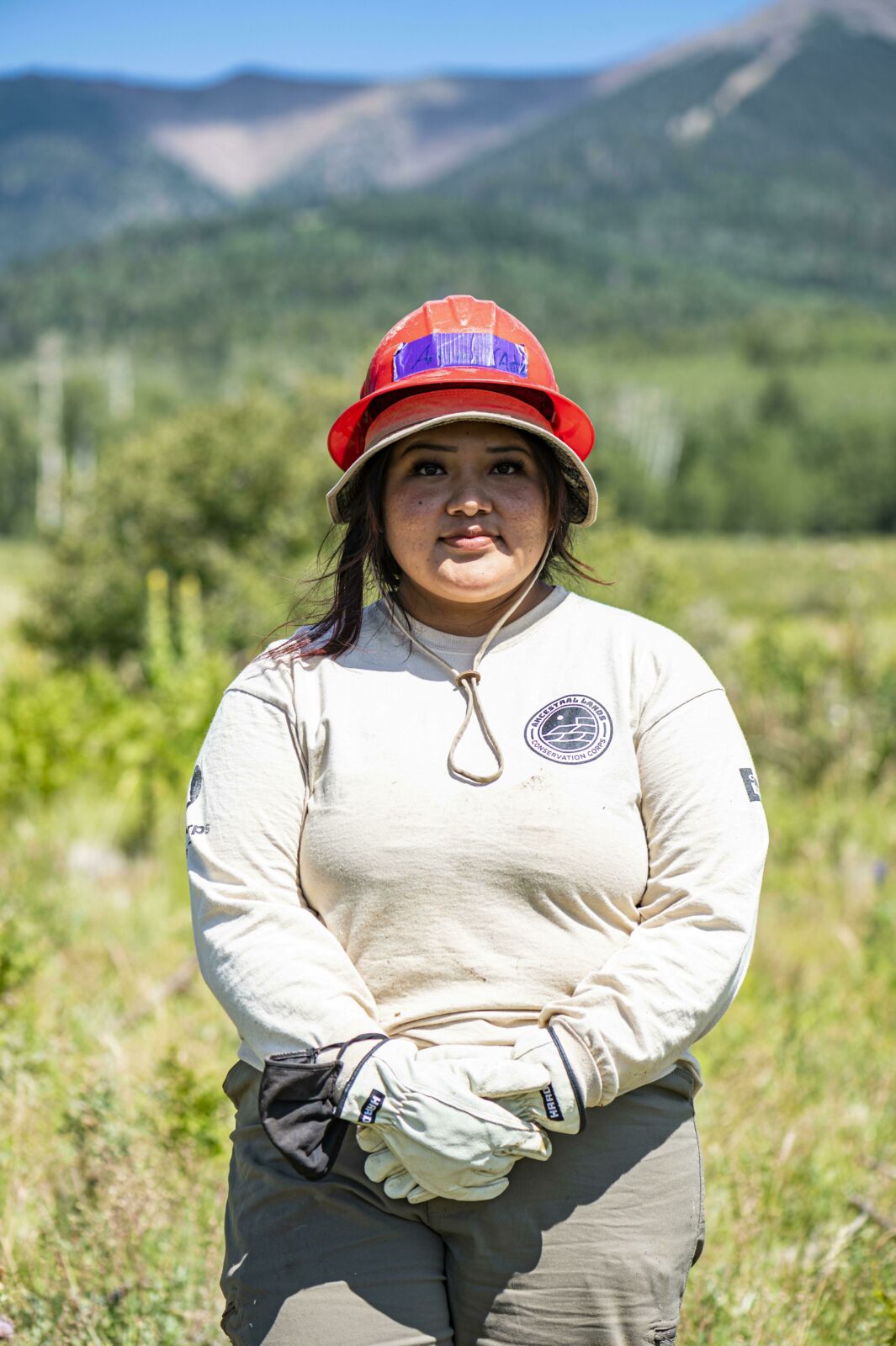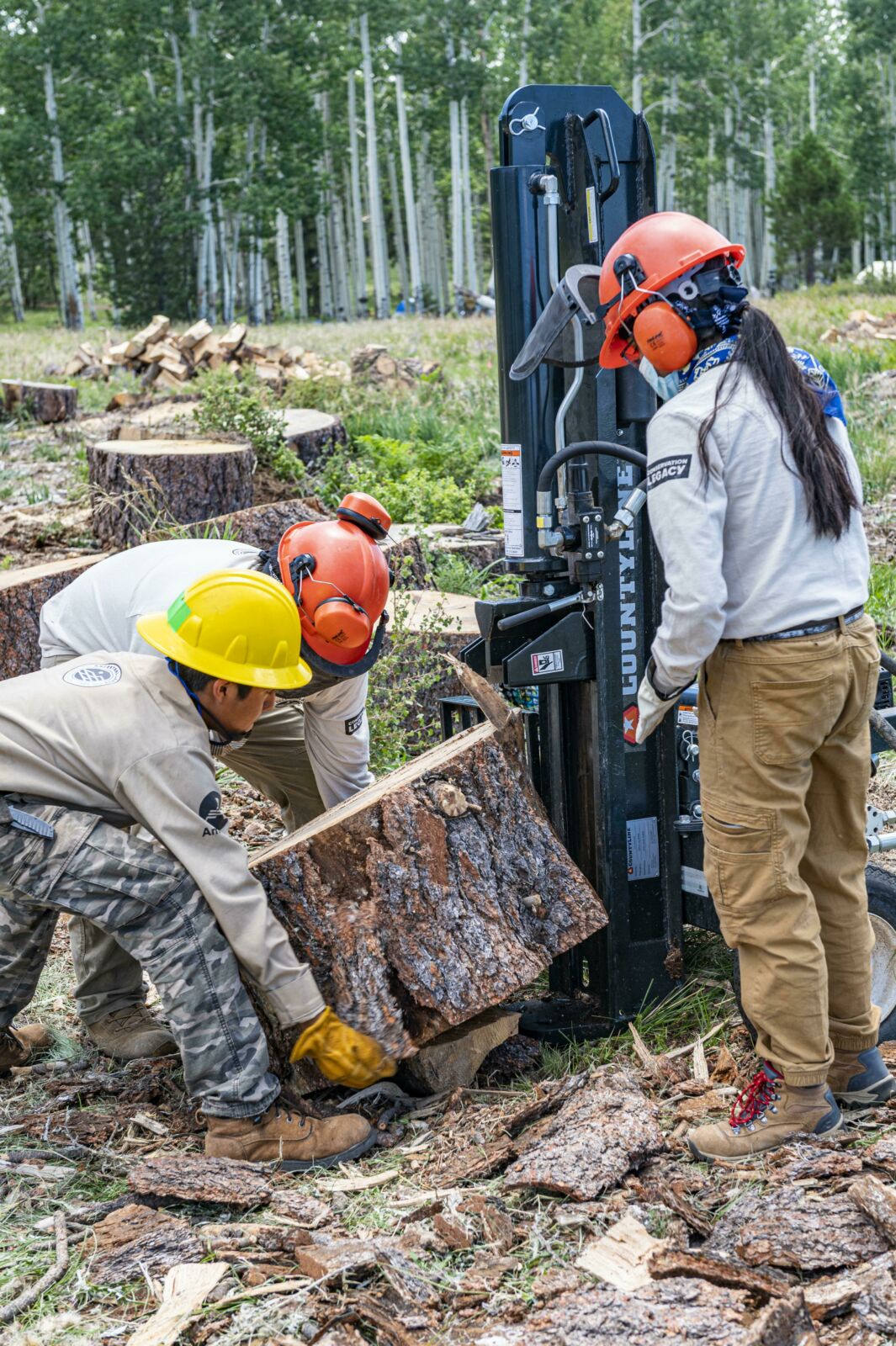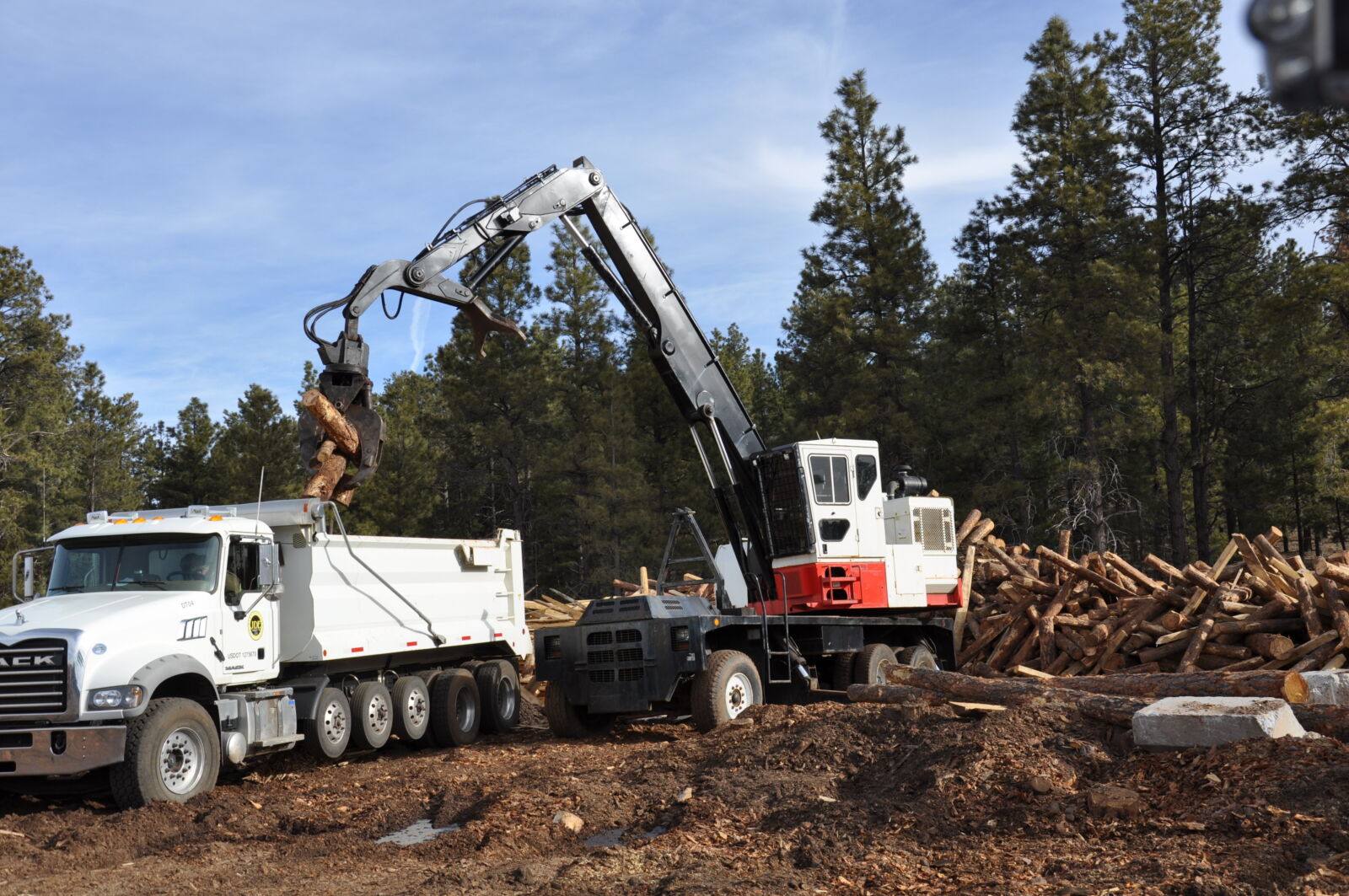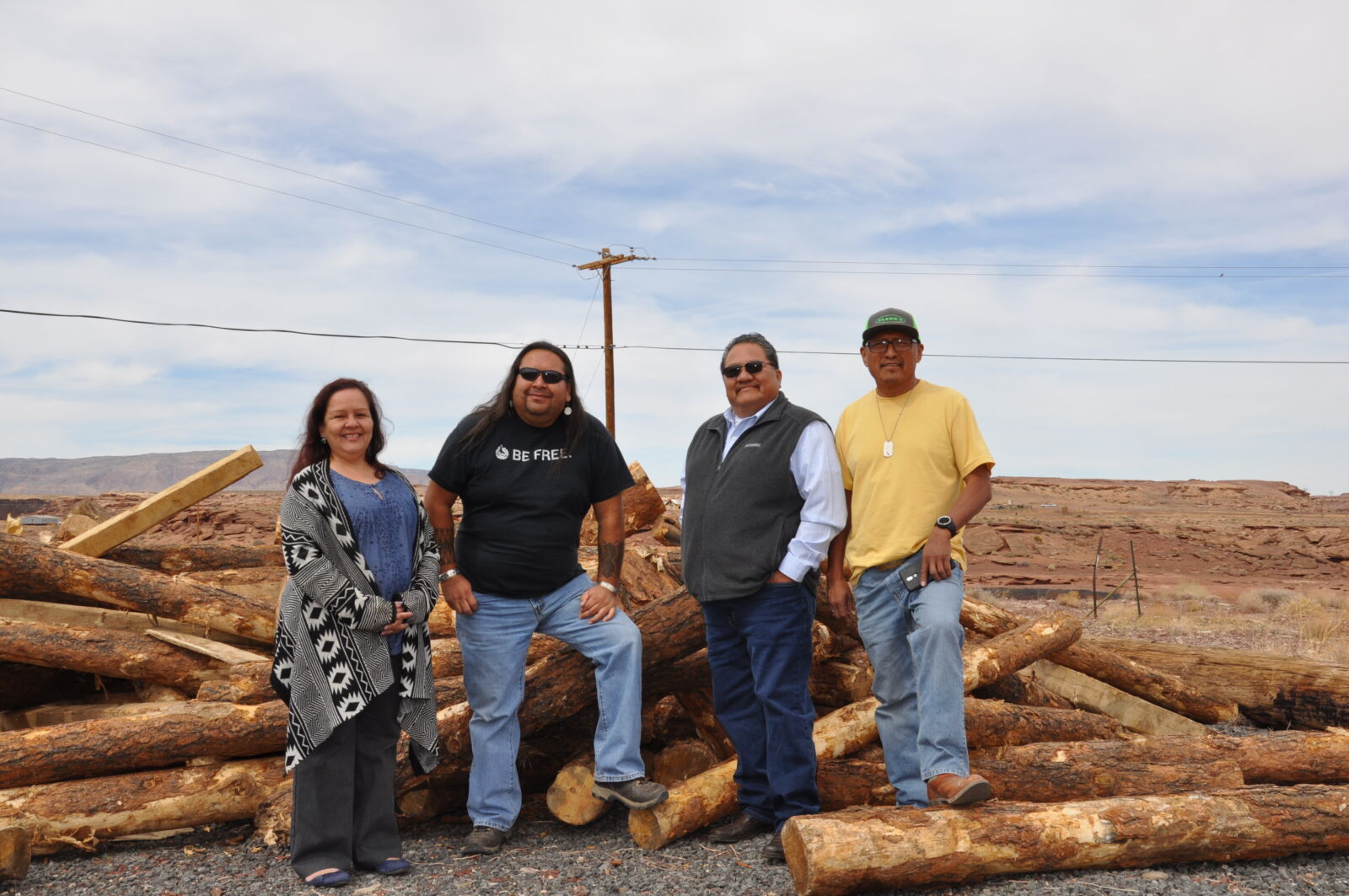Janice Manuel sits beneath a small stand of ponderosa pines on a hot summer day. The trees are an island of shade in the middle of sunny Hart Prairie, the massive, wide open meadow green from summer monsoons.
Sprinkled among the tall grasses, wildflowers, and Bebb’s willows (the southernmost stand of Bebbs in the world) are 20 or so 20-somethings, all Hopi and Tewa. Like Manuel, they are workers for Ancestral Lands, an Indigenous conservation corps tasked with removing waste wood from sunny Hart Prairie, a wide open meadow near Flagstaff, Arizona. Above them is the rugged skyline of the San Francisco Peaks, known as Nuva’tukya’ovi, or “The Place of Snow on the Very Top,” to Manuel’s people.
The sounds of chainsaws and hydraulic log splitters permeate the air, making it difficult to hear what Manuel has to say.
“Well,” she starts softly, seemingly uncertain whether I will find her story as relevant as she does.
“About the coal?” She pauses.
Then she smiles. Her face seems to glow from the inside as she recalls cold winter mornings in the village of Bacavi on Third Mesa, about 100 miles northeast from where she stands. Manuel and her cousins would wake, take showers, then huddle in front of the stove to warm up while their grandparents combed their hair. It’s clear by her expression and tone that it’s a good memory—a cherished one.
“Just sitting next to that warm fire,” she says. “That’s what I think about when I think about coal.”

Photo by Jen Magnuson Photography

Photo by Jen Magnuson Photography
On November 18, 2019, the biggest coal-burning power plant in the American West consumed its last load of coal. Located outside of Page, Arizona, and adjacent to the Navajo and Hopi nations, Navajo Generating Station (NGS) had long been on the fritz. With mounting repair bills, falling prices in competing energy utilities, and coal’s general notoriety as a carbon polluter, the shutdown wasnot a question of if, but when.
While climate activists applauded the shuttering of NGS, the closure caused massive problems for the Navajo and Hopi. Close to 750 jobs were lost overnight. Timothy Nuvangyaoma, Chairman of the Hopi nation, then and now, estimated that the NGS closure would cause a $12 million revenue loss,roughly 80-85 percent of the tribe’s general fund budget. If the budget cuts were bad, what was arguably worse was the sudden loss of access to inexpensive and often free fuel from the mine that also fed the NGS.
“Everybody [on Hopi] relies on coal as their primary heating source,” said Marshall Masayesva, Hopi Program Manager for Ancestral Lands. “When [NGS] closed…nobody was prepared.”
With winter temperatures regularly dipping into the teens or below and the coldest season rapidly approaching, a long-relied upon source of heat and cooking fuel had suddenly disappeared. The Navajo and Hopi nations needed fuel, and fast.
Meanwhile, the Coconino National Forest in northern Arizona had a fuel excess it was actively trying to get rid of. After several decades of fire suppression, the Coconino—like many western forests—is so overgrown that if and when a fire happens, it burns hotter and more catastrophically than it historically would have. When a modern forest fire rips through a stand of trees, it often doesn’t just take out the understory. It also kills the old growth.
One obvious solution is to simply thin the forests, but that can be prohibitively expensive. “Logging has taken a beating over the last 30-40 years,” says Jake Dahlin, who manages the Flagstaff Watershed Protection Project for the Forest’s Flagstaff Ranger District. “The costs of diesel coupled with the lack of truckers has made it… economically unfeasible to log timber.”
“Everybody [on Hopi] relies on coal as their primary heating source. When [NGS] closed…nobody was prepared.”
In late 2019, Tribal officials and Forest Service staff saw an elegant way to address both problems simultaneously: Take wood from overgrown forests, turn it into firewood, and bring it to Navajo and Hopi communities in need. They called the initiative Wood For Life.
Today, Wood for Life is in full swing, with projects completed or underway on Bill Williams Mountain, Lockett Meadow, and Hart Prairie. Crews have chopped more than 1,600 cords of wood, which the program has transported to Navajo and Hopi families, and as of fall 2021 an estimated 1,150 cords more are in the works.

Wood dedicated to the Wood for Life efforts is loaded for transportation at a sawmill.
“It’s a win-win situation,” Masayesva says while filing the teeth on his chainsaw. “One, we’re providing fuel to our community. Two, we’re actively engaging as stewards of the land on projects that are being initiated by organizations like the National Forest Foundation and the Forest Service. To me it’s a perfect example of how nonprofits, NGOs, and agency partners can work together.”
Situations like these are fairly rare in the conservation world. Far more common are stories like the NGS shutdown, in which a so-called climate victory is accompanied by loss of jobs, or other disasters for often marginalized communities.
Consider electric cars, which require lithium batteries. Getting that lithium has often meant mining in socioeconomically depressed regions like the Atacama Desert in Chile, where Indigenous lands have been decimated by this so-called “green” industry.
As Masayesva said, what makes Wood for Life so special is that everyone wins. The Coconino National Forest and surrounding communities are minimizing the risk of severe forest fires in a low impact way. And, the Navajo and Hopi are accessing an affordable solution for some of their fuel needs. So it’s no surprise that the program has generated a lot of excitement and enthusiasm.
“We have Congressional staffers contacting us, asking how they can implement something like Wood for Life more broadly,” says NFF Arizona Program Manager Sasha Stortz. In fact, there’s even reason to believe Wood for Life may serve as a pilot for other National Forests around the country.

Cameron Chapter House Tribal Leaders receiving fuelwood.
That said, Stortz is quick to clarify that Wood For Life is not intended to be a long term solution. It’s more of a transitional period—a bridge over the next decade or two between the past (coal) and the future (wind and solar).
Ultimately, there are less carbon-heavy ways to heat homes and cook than burning wood. But using wood in this way is much less impactful than a full scale wildfire. Simply by removing fuels from the forest, Wood for Life contributes to the forest restoration needed to reduce the carbon emissions from high severity wildfires.
“We have to come at all this with humility, but we also have a responsibility to act,” Stortz says. “There can be good fire, even in the forest we have now, but I’ve also seen fires that burn so hot and so intensely that trees won’t come back on their own. Doing nothing is accepting something that I am not personally ready to accept.”
When we consider possible solutions to big problems like the climate crisis, we often forget to look beyond facts and figures. What’s more difficult, but imperative, is to be cognizant of how big policy changes affect all the communities involved—especially ones that have been traditionally excluded and exploited.
“It’s a win-win situation. One, we’re providing fuel to our community. Two, we’re actively engaging as stewards of the land on projects that are being initiated by organizations like the National Forest Foundation and the Forest Service. To me it’s a perfect example of how nonprofits, NGOs, and agency partners can work together.”
On paper, the NGS shutdown was a good idea. From a climate perspective, it still is. But when you look beyond the carbon footprint, you see people like Janice Manuel, for whom the end of coal presents an uncertain and chilling future. Wood for Life is an innovative and promising way to make sure Navajo and Hopi families are not left behind when big steps are taken toward reversing climate change. It’s one way to make sure that cherished tradition of Manuel’s—winter mornings with her cousins warming up beside the fire—can still have a place in a post-coal world.
Learn more and donate to the Wood for Life program at nationalforests.org/woodforlife.
About the Author
Chris Kalman is a freelance journalist and the author of two novellas: As Above, So Below (a finalist for the Mountain Fiction and Poetry Award at the 2018 Banff Mountain Film Festival), and Dammed If You Don’t (winner of the 2021 Banff Mountain Fiction and Poetry award). You can buy books and learn more at chriskalman.com.

